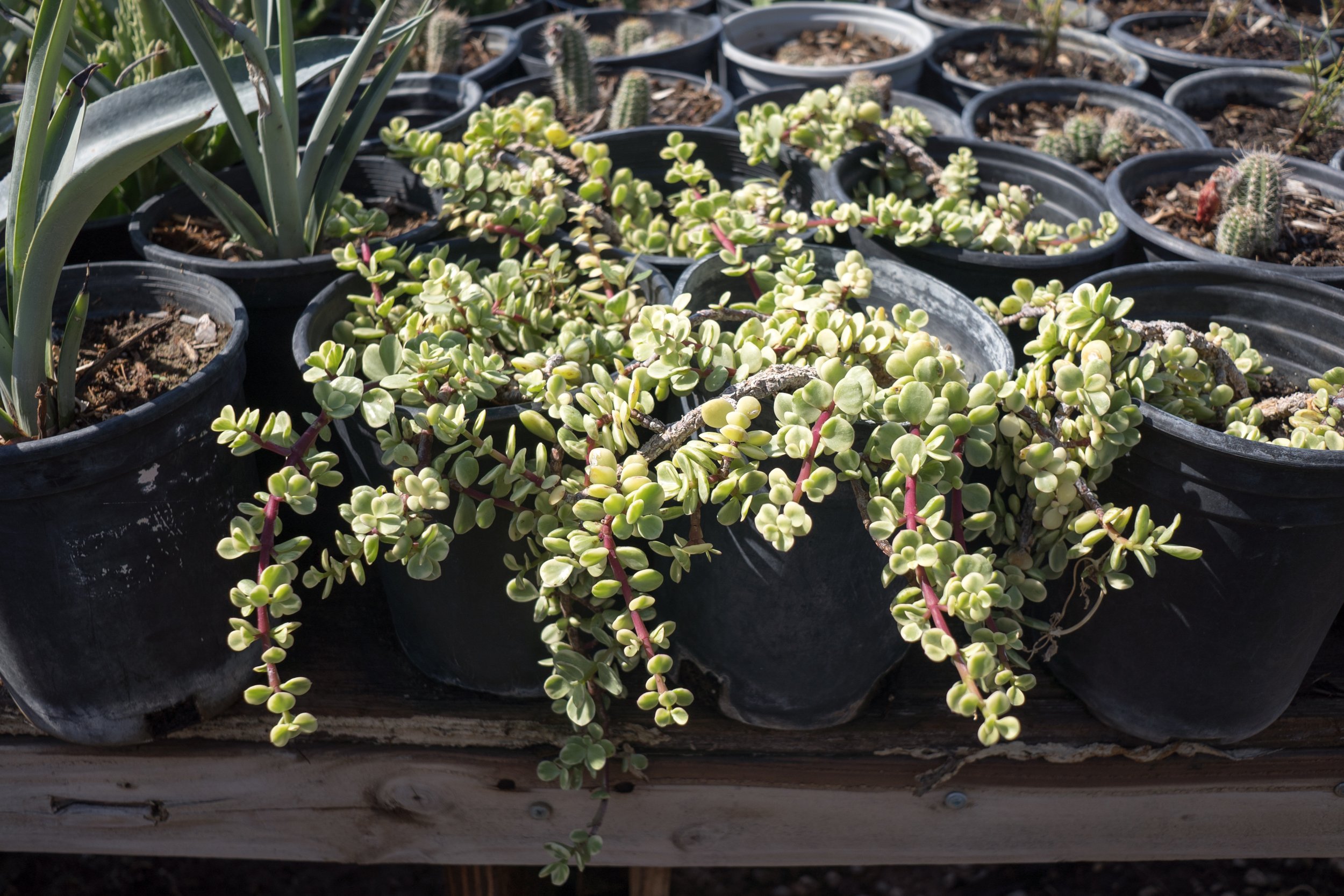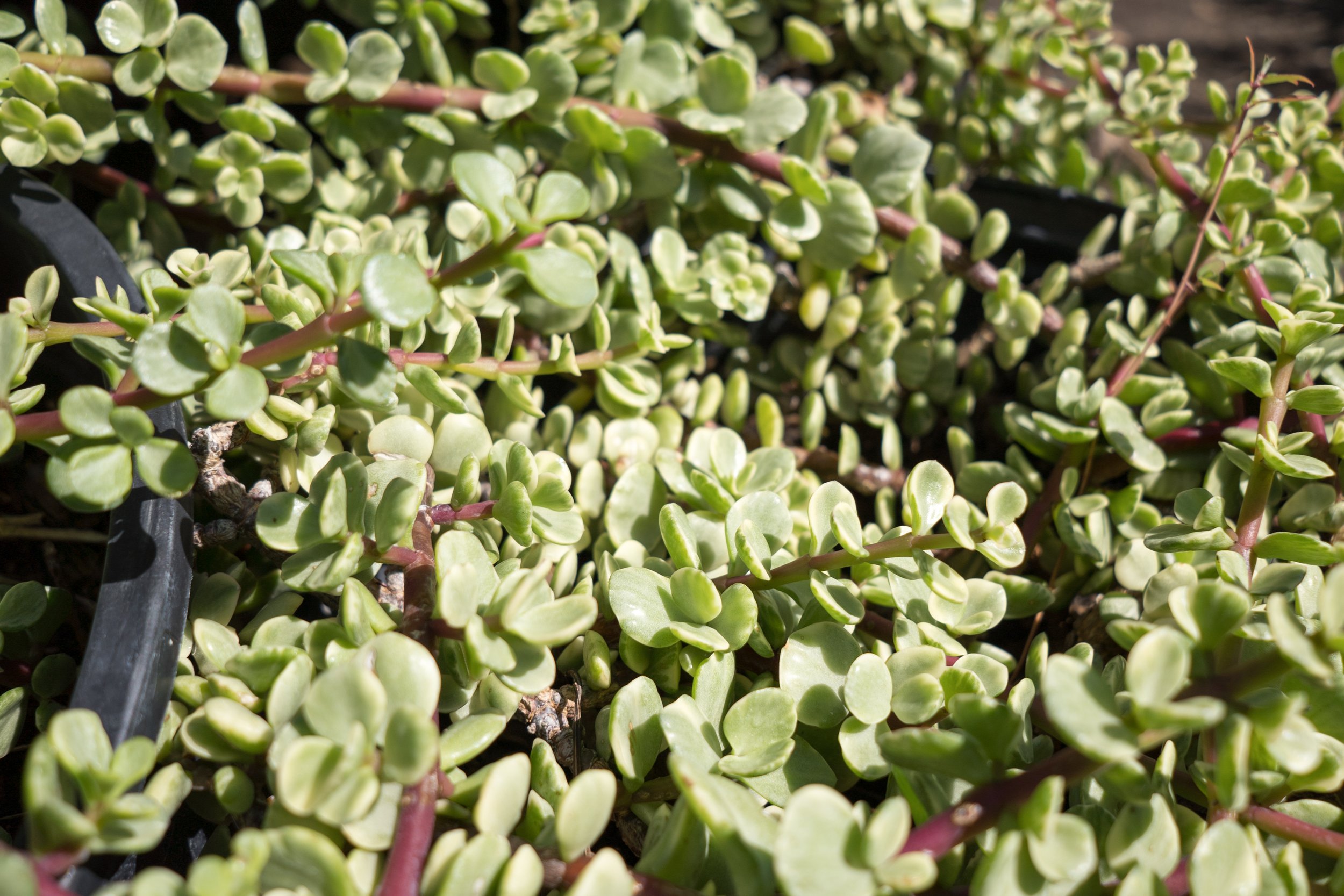Elephant Food
Hailing from Southern Africa, Elephant food is a miracle plant that can resist the heat and drought of even the Coachella Valley desert.
With its recognizable long stems and small succulent leaves that grow in pairs, if you've been in Southern California, you've probably seen it playing various roles in a garden, including as a ground cover, hedge, and potted plant.
The adaptability to the desert and versatility to various settings make this plant a sure winner!
Botanical name: Portulacaria afra
Other names: Dwarf jade plant, Elephant bush, Elephant’s food, Porkbush, Spekboom
Elephant food plant for sale at the nursery
TABLE OF CONTENTS
Elephant Food Appearance
Elephant's food has a very distinguishable shape and growth habit.
Numerous, long, segmented stems that are dark maroon in color and soft-wooded and succulent in texture. Older stems become thicker and more rigid. Eventually, when very mature, Elephant's food can become a tree.
Leaves resemble that of a Jade plant, although they are smaller than Elephant food. They are small, round, and bright green, growing alongside the stems in pairs. The succulent leaves store water and are plump when well-watered and shriveled when not.
One popular variegated form has green leaves with cream-colored edges.
Small, pink flowers when in bloom, which rarely occurs in the Coachella Valley.
Elephant food is typically seen as a 4+ foot shrub in California. However, in the wild, they can grow to 15+ foot trees and dense shrubs, where animals forage and start new plants by dropping leaves and stems on the ground.
Elephant Food Landscaping Tips
Elephant food can be used in various settings in the garden due to its unique growth habit and adaptability to pruning.
It can be used as a drought-tolerant ground cover. Keep in mind that eventually, the plant can become quite tall without any pruning.
Once very mature, can be used as a hedge.
To keep height in check and/or to create a cascading effect, keep the plant in a hanging basket or tall planter. Works well alone and in succulent arrangements.
Elephant food is very robust and very easy to prune and shape. An excellent, popular candidate for training as a bonsai tree.
If kept in full sun in the Coachella Valley, we recommend the standard Elephant's food rather than the variegated type.
A good candidate for edible landscaping. Elephant's food cannot only be eaten by elephants, but tortoises and goats as well, and we can eat them too! It is a common ingredient used in South African cuisine to add tartness to salads and soups.
Elephant Food Origin
Elephant bush is native to Southern Africa, where it is warm and dry.
Variegated Elephant food for sale at the nursery
Elephant Food Care
Elephant's food is an easy plant to take care of in both coastal Californian regions as well as the inland desert.
Soil: Loose, well-draining soil that is lightly fertile.
Temperature: Can withstand temperatures down to 30 degrees for a short period of time. Does very well in the heat.
Water: Elephant food is very drought tolerant. Occasional, deep watering. Allow the soil to completely dry out between waterings. Either use a moisture meter or stick your finger through the soil to gauge the moisture level.
Sun: Full sun. Partial shade in the Palm Springs region is ok.
Elephant Food Problems
Pests: Elephant food is not prone to attracting pests. The most common ones are mealybugs and spider mites.
To remove mealybugs, use insecticidal soap or apply rubbing alcohol directly to the area of the infestation using a cotton swab.
To remove spider mites, use horticultural oil for crawlers and insecticidal soap for mites of all stages.
Whenever using any kind of pesticide, be aware that it can damage the plant if the temperatures are in the 80s or above.
Fungal diseases from root rot, dry rot, and harsh weather conditions.
Signs of overwatering: Drooping, squishy texture, leaf fall
Signs of too little water: Shriveled leaves, leaf fall
Signs of too much sun: Burning, fading leaves
Signs of too little sun: Etiolation, stunted growth
Elephant Food Propagation
Elephant's food propagates easily. Take stem cuttings, and plant in moist soil or root in water.
FAQ
How much does Elephant Food cost?
At our nursery, Elephant food costs $10 for a 1-gallon container, $20 for a 5-gallon container and $65 for a 15-gallon container.
Prices are subject to change. Please contact us for the most up-to-date information on pricing. We may have larger sizes available. We provide installation services locally at a separate cost.
Can you eat elephant food?
Yes, humans can eat the leaves of the elephant food plant, even in the raw form. It is a common ingredient used in South African cuisine to add tartness to salads and soups.
Does Elephant Food/Portulacaria afra flower?
Yes, given warm temperatures and dormant winters, Elephant food will form small, pink flowers.
Summary
| SIZE (H X W) | 6-8 feet x 6-8 feet |
|---|---|
| FLOWER COLOR | Pink |
| FLOWER SEASON | Winter to Spring |
| EXPOSURE | Full Sun/Partial Shade |
| WATER | Low |
| GROWTH RATE | Moderate to Fast |
| HARDINESS | 30º F, USDA Zone 10 |
| PRUNING | As needed |



